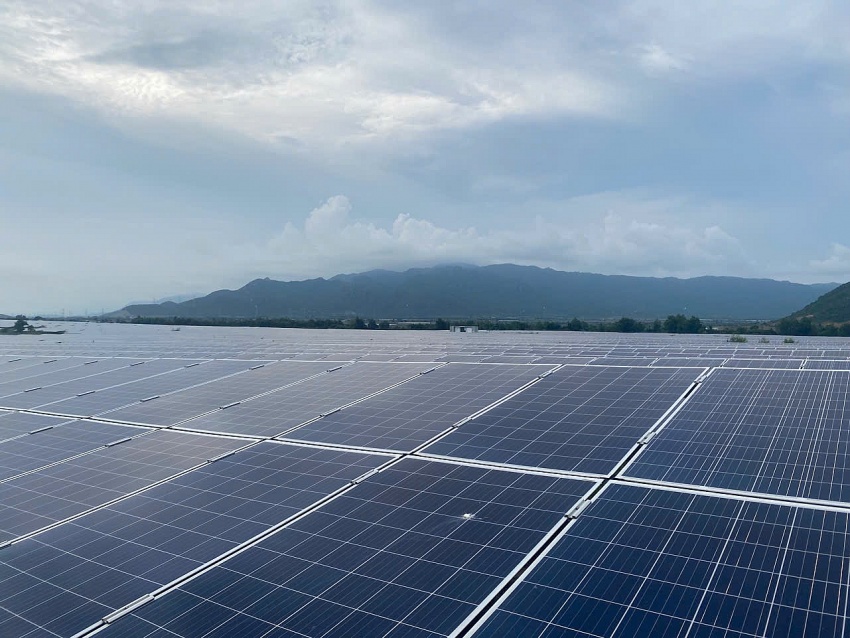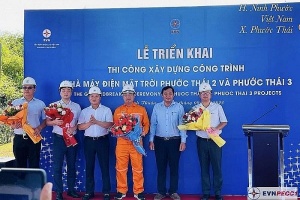High-quality workforce embedded in Ninh Thuan's renewable energy development
To harness its vast renewable energy potential, which Statista estimates at 120.30 billion kWh with an annual growth rate of 3.39 per cent from 2024 to 2029, Ninh Thuan, the region with the most favourable natural conditions in Vietnam for such development, recognises that without a skilled workforce, natural advantages alone cannot drive the industry towards sustainable growth.
 |
| Solar power facilities require skilled engineers for maintenance. |
Nguyen Phan Quoc, principal of Ninh Thuan College, told VIR last week that the college has been tasked with building a workforce training plan to transform Ninh Thuan into the country's renewable energy centre.
“We launched renewable energy training in 2021. After adopting a training programme from Germany, we developed a vocational programme on rooftop solar energy, which has been recognised by the Ministry of Labour, Invalids, and Social Affairs. The college is also implementing a wind power services training course, set to begin this month,” Quoc said.
Although the technology in the sector evolves rapidly, Quoc remains optimistic that students will remain updated with the latest skills.
“Since 2018, we have received support from the German International Cooperation Organisation (GIZ) to enhance our training capacity, with 17 teachers attending solar and wind energy courses led by German experts. GIZ has also provided $700,000 to establish the Centre of Excellence for Renewable Energy at the college,” Quoc continued.
Additionally, with a strong emphasis on aligning training with business realities, the passionate principal expressed gratitude for the support from enterprises.
“We are fortunate to have received support from businesses during the development of our training programmes. The college has now established a vocational advisory board for renewable energy, with participation from various local and national businesses. Businesses collaborate with teachers to design and conduct training directly in the workplace, ensuring that graduates meet job requirements,” he shared.
Quoc proudly highlighted positive feedback from enterprises based on the college’s survey on students’ knowledge, skills, and attitudes, with companies expressing high satisfaction with the quality of graduates.
As of September, according to Ninh Thuan People's Committee, the province is home to 11 wind power plants and 35 solar energy projects, with total capacities of 667MW and 2,466MW, respectively, all of which are now commercially operational.
The training of high-quality human resources is especially crucial as it contributes to the industry’s localisation goals, as outlined in the national power development plan. According to Le Chi Hiep, former chair of the interdisciplinary council on environment, resources, and energy at Vietnam National University, Ho Chi Minh City, reducing dependence on imported energy requires ensuring the capability to execute and operate domestic projects.
“Power Development Plan VIII (PDP 8)encourages the development of domestic renewable energy projects. For these projects to succeed, a skilled workforce is essential for effective implementation, construction, and operation. A local workforce with high expertise will help Vietnam reduce reliance on foreign experts and ensure self-reliance at every stage, from design to installation and maintenance,” Hiep said.
“To achieve localisation, we need a workforce capable of operations and experts who can research, develop, and manufacture renewable energy-related technologies. Training high-quality personnel will accelerate the growth of domestic energy production technologies, reduce the cost of importing technology, and create opportunities for local businesses to participate more deeply in the value chain,” he added.
PDP 8 identifies renewable energy as a key part of the national energy independence strategy. Achieving energy self-sufficiency requires a high-level workforce not only in technology but also in management, planning, and strategy. A well-trained domestic workforce will help optimise operations, enhance efficiency, and minimise risks in renewable energy development.
Hiep emphasised that employing local workers helps cut costs associated with hiring international experts and strengthens the competitiveness of Vietnamese businesses in the energy market. “With a high-quality workforce, companies can optimise processes, reduce construction time and costs, and improve energy production efficiency,” he said.
Moreover, Hiep mentioned the positive ripple effects on supporting industries.
“High-quality personnel will drive the development of supporting industries related to renewable energy, such as equipment manufacturing, component production, and maintenance services. This helps build a sustainable supply chain, allowing local businesses to participate more deeply in the sector and contribute to the localisation process,” said Hiep.
Truong Thi Chi Binh, executive vice president and general secretary of the Vietnam Association of Supporting Industries, acknowledged the limited involvement of Vietnamese enterprises in the renewable energy sector.
“As of now, most renewable energy plants are built using imported equipment. For Vietnamese businesses to join this supply chain, time is needed for preparation, including workforce development, while renewable energy projects are expanding at a rapid pace,” Binh said.
 | Navigating Asia-Pacific’s renewable energy landscape Despite starting from a low base, renewable energy is experiencing robust growth in Asia-Pacific, with installed generation capacity increasing at an average compound annual growth rate of 9 per cent. By 2030, renewable energy is expected to account for 30-50 per cent of the power generation mix across most Asia-Pacific markets. |
 | Ninh Thuan’s renewable projects facing delays According to Ninh Thuan Department of Industry and Trade, two solar power projects remain on hold, awaiting the revised implementation plan for an extension, while wind power projects have yet to receive a pricing mechanism to begin construction. |
 | Australia and Vietnam join forces to cultivate quality workforce for net-zero future Vietnam and Australia view the green economy as a vital area for cooperation, with Australia’s ambition to lead in renewable energy aligning with Vietnam’s focus on wind and solar development. |
What the stars mean:
★ Poor ★ ★ Promising ★★★ Good ★★★★ Very good ★★★★★ Exceptional
Related Contents
Latest News
More News
- Honda launches electric two-wheeler, expands charging infrastructure (January 12, 2026 | 14:00)
- Vietnam striving to ease air pollution (January 09, 2026 | 14:41)
- Petrovietnam Gas awards first multi‑year LNG deal to Shell (January 09, 2026 | 14:38)
- Advancing the net-zero journey: Carlsberg Vietnam’s sustainability progress in 2025 (January 09, 2026 | 09:49)
- The green hydrogen and ammonia future for Vietnam (January 06, 2026 | 15:03)
- Green transition to close $20 billion annual investment gap (December 31, 2025 | 11:59)
- Australia contributing to Vietnam’s climate change responses (December 30, 2025 | 11:37)
- CME Solar strengthens position in Vietnamese renewables (December 30, 2025 | 11:21)
- Self-care signals shift towards sustainable healthcare (December 30, 2025 | 10:12)
- GreenYellow marks five years of clean energy growth in Vietnam (December 26, 2025 | 15:51)

 Tag:
Tag:



















 Mobile Version
Mobile Version